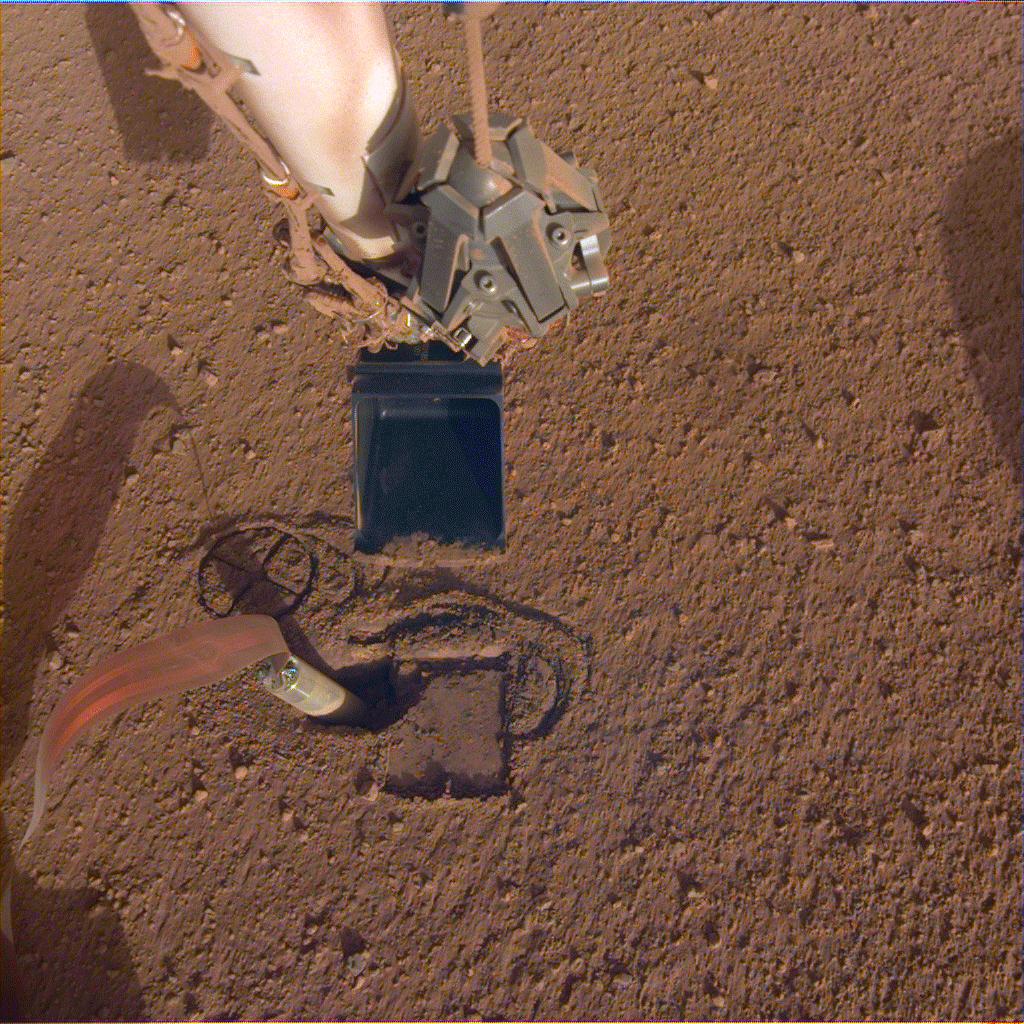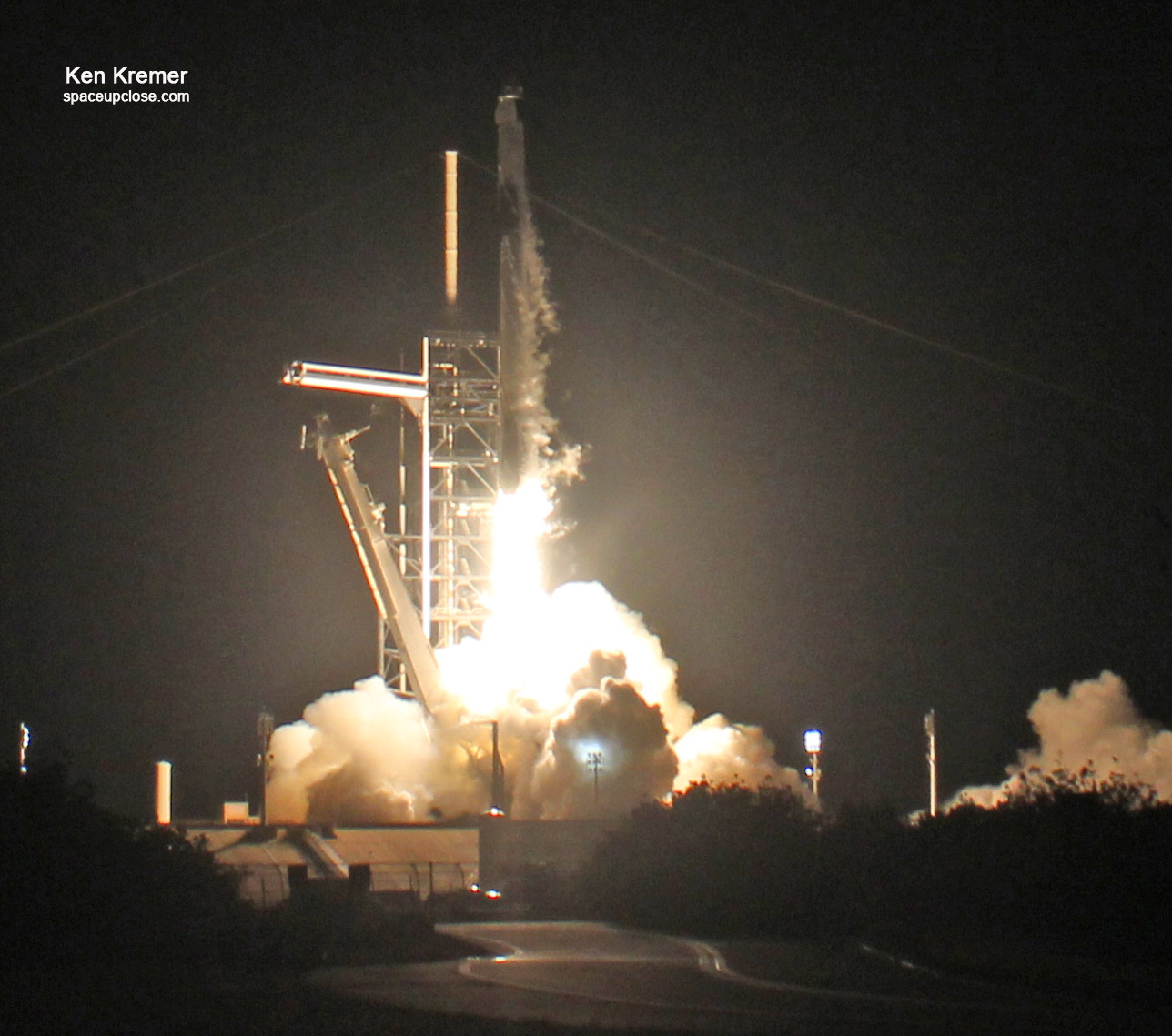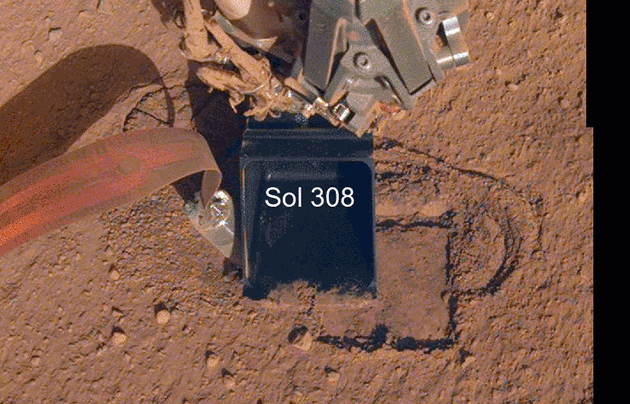
For SpaceUpClose.com & RocketSTEM
CAPE CANAVERAL, FL- The German Mole is on the move at last on Mars on NASA’s InSight lander after a lot of hard work by engineers on both sides of the Atlantic have has finally paid off trying to save the stuck deep penetrating heat probe on the agency’s spacecraft designed explore the deep interior of Mars – since successfully soft landing last November.
Since early October the combined team has been trying to unstick the mole by commanding InSight’s robotic arm to assist the spacecraft’s self-hammering heat probe using a new strategy known as ‘pinning’.
The lead video above shows the mole digging about a centimeter (half an inch) below the surface last week over the course of a several Martian days, or Sols.
And the penetration is continuing today as evidenced from newly received images taken on Oct. 23 (Sol 324) and Oct. 24, 2019 (Sol 325).
The mole is part of an instrument called the Heat Flow and Physical Properties Package, or HP3, which was provided by the German Aerospace Center (DLR).
Since then even further progress downwards has continued in the latest report today, Friday, Oct 25, from HP3 Principal Investigator Tilman Spohn of DLR.
The team is happy to report that ‘pinning’ has succeeded and the ‘mole’ is once again digging down ever deeper into Mars further than ever before.
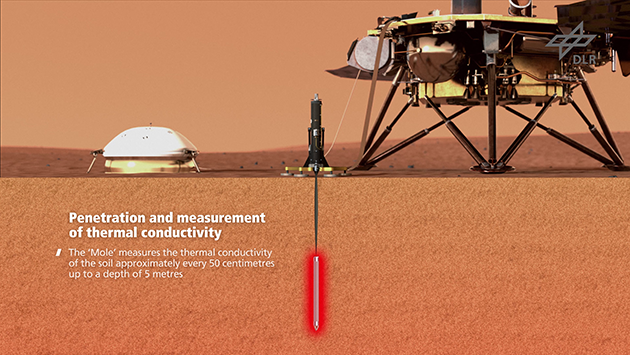
The mole had been unable to dig more than about 14 inches (35 centimeters) since it began burying itself into the ground on Feb. 28, 2019.
It has the capability to dig as much as 16 feet (5 meters) underground to gauge the heat escaping from the planet’s interior.
“More good news from Mars: The Mole has digged further even after releasing the pinning!” wrote HP3 Principal Investigator Tilman Spohn of DLR.
“On sol 318 we had the Mole execute 150 more strokes that brought the back-cap of the Mole so close to the scoop that continuing with pinning was no longer considered safe. By that time, the Mole had digged a total of 4-5 centimeters under pinning. If we had the Mole dig further with the scoop pinning, it could have moved underneath the scoop at which point the arm would have made an uncontrolled sideways swing releasing the tension. That way the scoop could have hit and damaged the tether. Therefore, on sol 319, the tension was released by moving the scoop slightly away from the Mole.”
“The images that we got down on 23 and 24 October clearly show that the Mole had digged further! Possibly a little faster than during the pinning, my “eyeball” observation that needs to be confirmed.”
“We have commanded the Mole to perform 2 times 150 strokes on sol 325 [Oct 24, 2019] – intermitted by a readjust of the vertical push to compensate for possible regolith relaxation – and hope to see the Mole dig further. We will then increase the number of strokes per sol and hope to see it disappear from our view into the Martian regolith soon. That would be the point at which we would make plans to release the scoop and use the arm to replace the support structure.”
JPL reported on Oct 21 that the mole has now estimated to have moved about 38 centimeters altogether – and that the entire mole may completely penetrate beneath the Martin surface very soon!
The mole is digging deeper into #Mars thanks to the tremendous efforts by my team. Unofficial depth is ~38 cm down in the ground, almost the length of the mole (40 cm). This may be the last time we see the mole, more drilling later this week. #SaveTheMole #DiggingMars pic.twitter.com/c1sZsGSLxj
— NASA InSight (@NASAInSight) October 21, 2019
After extensive investigation the team determined that the self hammering probe was apparently failing to dig deeper due to a lack of friction from the Martian sand.
So they implemented a plan to press the side of the scoop on the robotic arm against the mole, thereby pinning it to the wall of its hole. This apparently increased friction enough to keep it moving forward or downwards when mole hammering resumed.
The team first reported the good news of movement last week.
“Good news from Mars, DLR´s ‘Mole’ has moved forward! The HP3 heat flow probe has moved a total of two centimeters (calculated from the image data by Troy Hudson and Bob Deen, JPL/Caltech) downward in three hammering sessions with carefully chosen 20 and then two times 100 strokes. It is difficult to accurately estimate progress without stereo images. The animation shows the combined movement stitched together from images of the instrument deployment camera IDC on the InSight lander,” wrote Spohn on oct 18.
“The clearly visible movement is very good news and confirms our leading theory that the mole failed to move forward because it was lacking friction from the Martian sand. In (some) analogy to your car you could say it was lacking ‘grip’. The plan will be continuing to use the scoop to provide ‘grip’ as long as the mole is sticking out.”
“The recent movement is the result of a new strategy, arrived at after extensive testing on Earth, which found that unexpectedly strong soil is holding up the mole’s progress. The mole needs friction from surrounding soil in order to move: Without it, recoil from its self-hammering action will cause it to simply bounce in place. Pressing the scoop on InSight’s robotic arm against the mole, a new technique called “pinning,” appears to provide the probe with the friction it needs to continue digging” says JPL.
Here are further details from NASA:
Since Oct. 8, 2019, the mole has hammered 220 times over three separate occasions. Images sent down from the spacecraft’s cameras have shown the mole gradually progressing into the ground. It will take more time — and hammering — for the team to see how far the mole can go.
“Seeing the mole’s progress seems to indicate that there’s no rock blocking our path,” said HP3 Principal Investigator Tilman Spohn of DLR. “That’s great news! We’re rooting for our mole to keep going.”
NASA’s Jet Propulsion Laboratory in Pasadena, California, leads the InSight mission. JPL has tested the robotic arm’s movement using full-scale replicas of InSight and the mole. Engineers continue to test what would happen if the mole were to sink beneath the reach of the robotic arm.
If it stops making progress, they might scrape soil on top of the mole, adding mass to resist the mole’s recoil.
If no other options exist, they would consider pressing the scoop down directly on the top of the mole while trying to avoid the sensitive tether there; the tether provides power to and relays data from the instrument.
“The mole still has a way to go, but we’re all thrilled to see it digging again,” said Troy Hudson of JPL, an engineer and scientist who has led the mole recovery effort. “When we first encountered this problem, it was crushing. But I thought, ‘Maybe there’s a chance; let’s keep pressing on.’ And right now, I’m feeling giddy.”
….
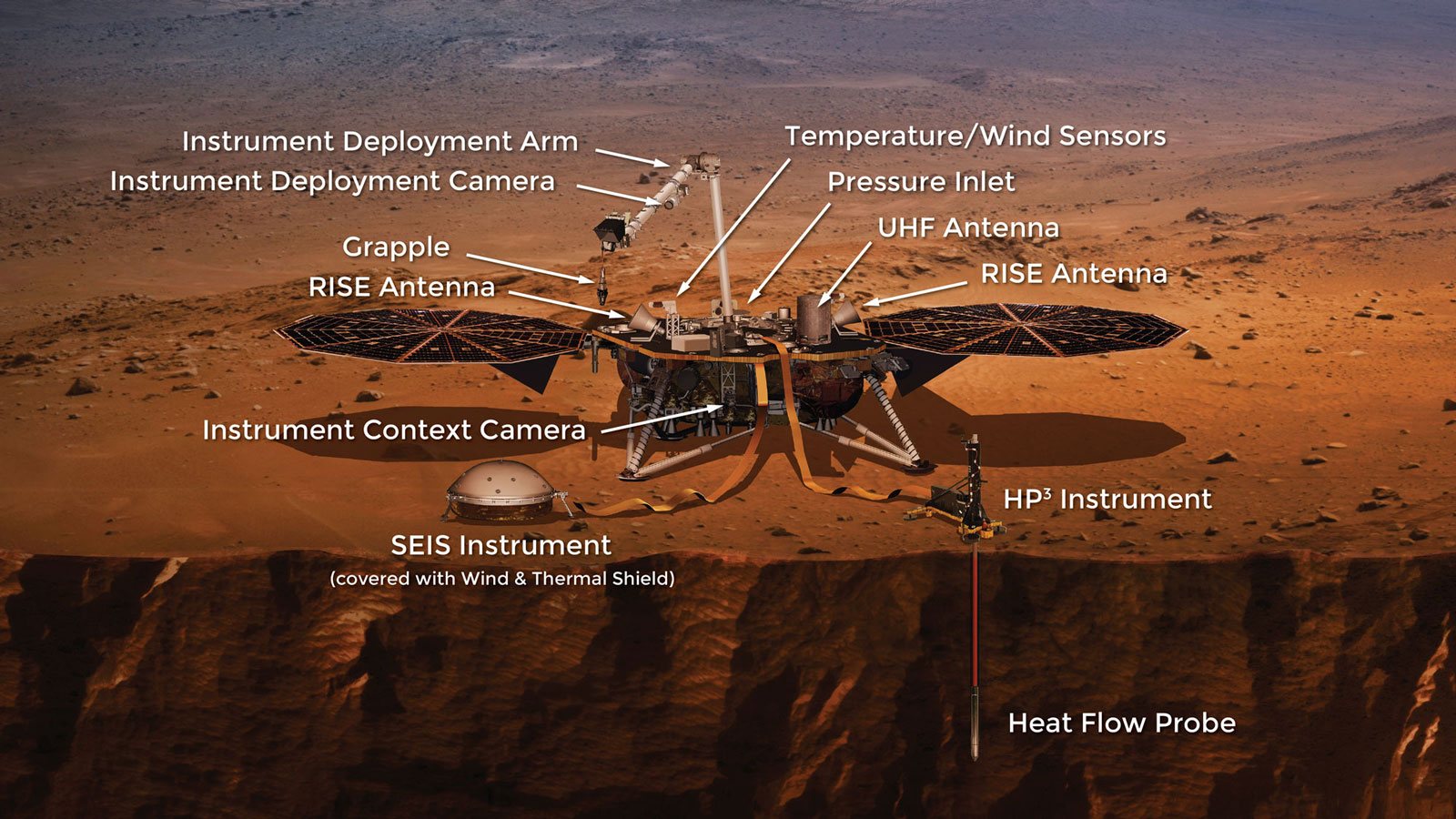
InSight soft landed on Mars on Nov 26, 2018 at Elysium Planitia, following a 7 month, 301 million mile (484 million km) interplanetary journey from Earth. She has begun a 2-year mission to explore the Red Planet’s mysterious deep interior.
InSight in an international science mission. Loaded aboard are the two primary science instruments provided by European partners from France and Germany: The SEIS seismometer and HP3 heat flow measuring instrument.
The SEIS seismometer instrument is equipped with a trio of incredibly precise seismometers to detect marsquakes and was provided by the Centre National d’Études Spatiales (CNES) – the French national space agency equivalent to NASA.
The second instrument measuring heat flow from the Martian interior is provided by the German Aerospace Center (DLR) and is named Heat Flow and Physical Properties Package (HP3).
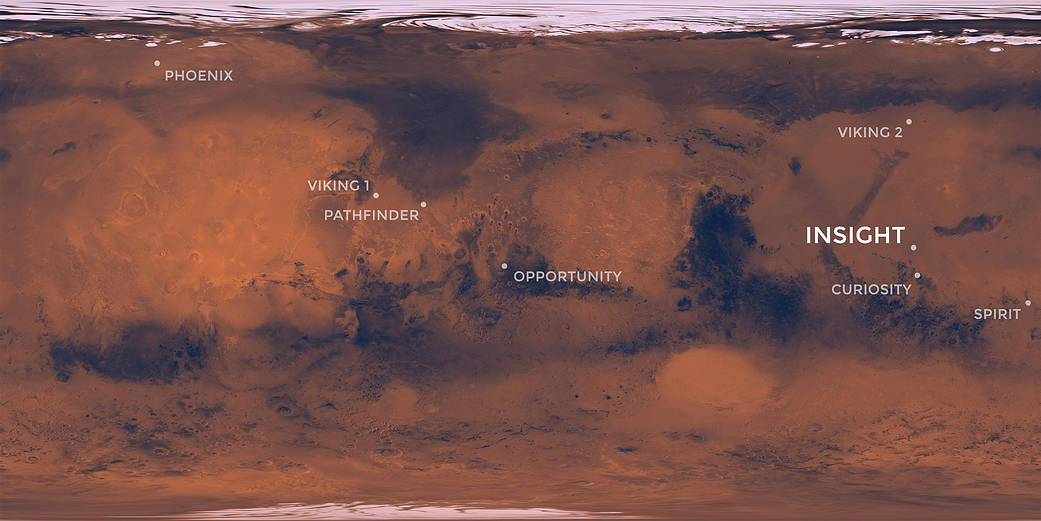
Stay tuned here for Ken’s continuing Earth and Planetary science and human spaceflight news: www.kenkremer.com –www.spaceupclose.com – twitter @ken_kremer – email: ken at kenkremer.com
Dr. Kremer is a research scientist and journalist based in the KSC area, active in outreach and interviewed regularly on TV and radio about space topics.
………….
Ken’s photos are for sale and he is available for lectures and outreach events
